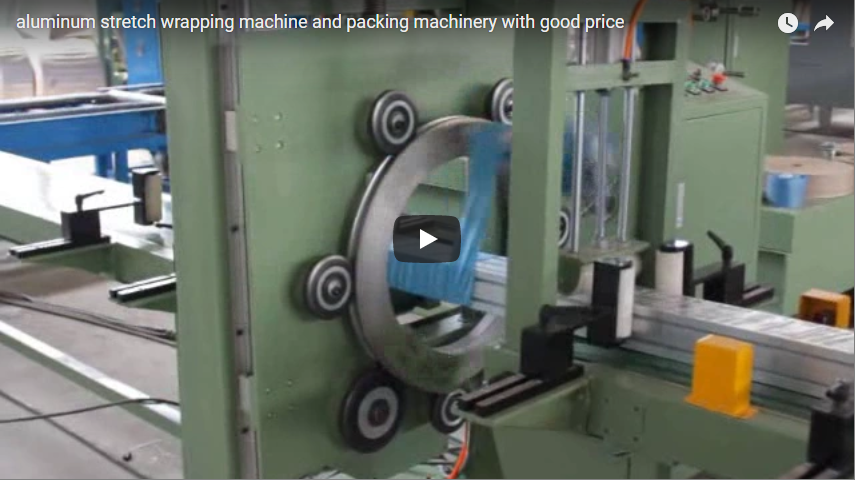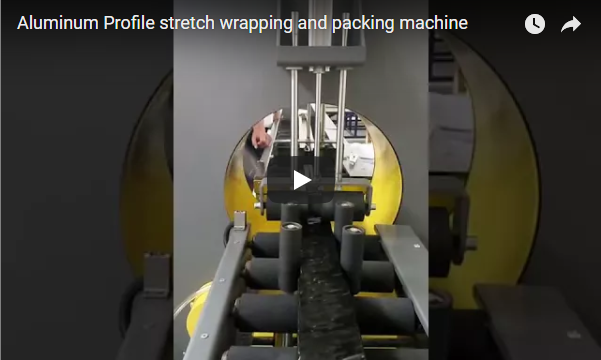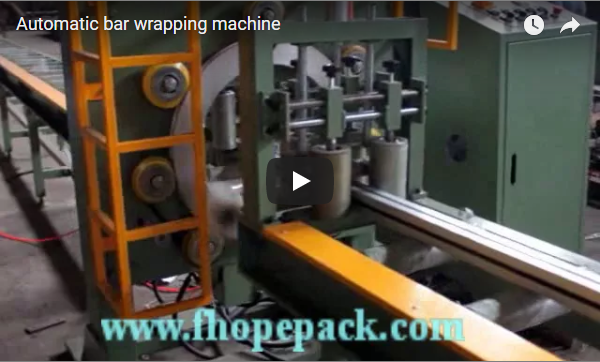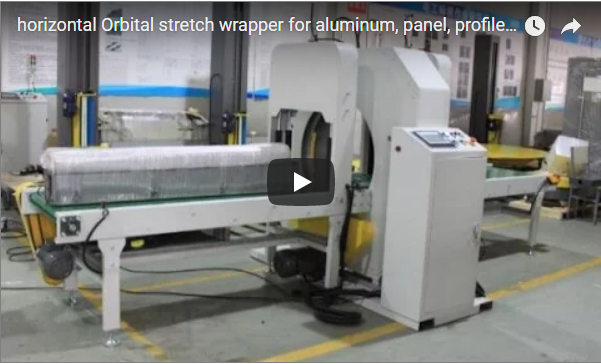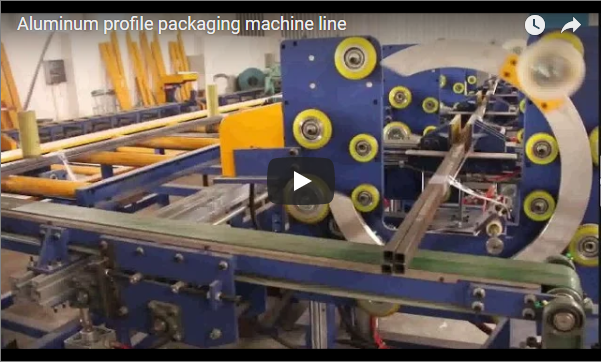Optimizing Aluminum Profile Packaging: A Deep Dive into Stretch Wrapping Technology
Aluminum extrusions, valued for their lightweight, strength, and corrosion resistance, present unique challenges during handling and transportation. Their often complex shapes, delicate surface finishes, and considerable length require robust packaging solutions to prevent scratches, bending, contamination, and other forms of damage. Inefficient packaging not only leads to material waste and costly rework but can also impact project timelines and customer satisfaction. Stretch wrapping has emerged as a highly effective method for addressing these challenges, particularly through the use of specialized orbital stretch wrapping machines designed for long products like aluminum profiles.
1. The Challenge: Protecting Vulnerable Aluminum Extrusions
Transporting and storing aluminum profiles involves several inherent risks:
- Surface Damage: Anodized, painted, or mill-finish surfaces are susceptible to scratching and abrasion during handling or transit if not properly protected.
- Bending and Deformation: Longer profiles, especially those bundled loosely, can bend or deform under their own weight or external forces.
- Contamination: Dust, moisture, and environmental contaminants can mar surfaces or interfere with subsequent processing steps.
- Handling Inefficiency: Loose or poorly secured bundles are difficult and unsafe to handle, move, and store using forklifts or cranes.
Traditional methods like manual wrapping or basic strapping may not provide sufficient protection or containment, especially for high-volume production environments.
2. Orbital Stretch Wrapping: The Engineered Solution
Orbital stretch wrapping machines are specifically engineered for packaging long, often bundled items like aluminum profiles, pipes, timber, and plastic extrusions. Unlike turntable wrappers where the load rotates, an orbital wrapper passes a film carriage around the stationary product.
Video Caption: Demonstration of an orbital stretch wrapping machine packaging aluminum profiles.
How it Works:
The aluminum profile or bundle is fed through the machine, typically on roller conveyors. A rotating ring, holding the stretch film roll on a carriage, orbits around the product as it passes through. The film carriage dispenses the stretch film under controlled tension, tightly wrapping the entire length of the bundle. Advanced systems often include automatic film clamping, cutting, and wiping mechanisms for a fully automated cycle.
3. Key Features and Technical Specifications
Modern aluminum profile stretch wrappers incorporate numerous features designed for efficiency, reliability, and flexibility. Key specifications often include:
- Wrapping Ring:
- Ring Diameter: Sized to accommodate the maximum cross-section of the bundle (e.g., 500mm, 900mm, 1600mm).
- Rotation Speed: Variable, often up to 100 RPM or more, directly impacting throughput.
- Film Carriage:
- Film Type: Designed for LLDPE stretch film.
- Film Width: Standard sizes (e.g., 100mm, 250mm).
- Pre-stretch System: Mechanical or powered pre-stretch (up to 250-300%) to maximize film yield and optimize load containment.
- Tension Control: Electronic or mechanical, ensuring consistent wrapping force without damaging profiles.
- Conveying System:
- Type: Powered or non-powered roller conveyors, belt conveyors.
- Speed: Often variable and synchronized with the wrapping process.
- Load Capacity: Designed to support the weight of maximum-sized bundles.
- Control System:
- Interface: PLC control with HMI (Touch Screen) for easy setup and operation.
- Programmability: Adjustable parameters like wrapping overlap, ring speed, conveyor speed, number of wraps at leading/trailing ends.
- Automation: Automatic film clamp, cut, and wipe functions.
- Performance:
- Throughput: Dependent on bundle length, ring speed, and conveyor speed (e.g., up to 15-20 meters/minute).
- Bundle Dimensions: Accommodates a defined range of minimum/maximum lengths, widths, and heights.
(Image Placeholder: Insert relevant image of the machine here, e.g.,  with appropriate Alt Text)
Alt Text Example: Orbital stretch wrapper applying protective stretch film to a bundle of aluminum extrusions on a roller conveyor.
4. Operational Advantages and User Experience
Implementing an orbital stretch wrapper for aluminum profiles delivers significant benefits:
- Superior Protection: Provides a tight, complete wrap that shields against scratches, dust, and moisture.
- Enhanced Load Stability: Securely unitizes bundles, preventing shifting during transit and improving handling safety.
- Increased Throughput: Automates the wrapping process, significantly outpacing manual methods and reducing labor requirements.
- Material Cost Savings: Film pre-stretch systems optimize film usage, reducing consumption per bundle compared to manual wrapping.
- Improved Presentation: Creates a professional, clean look for finished bundles.
User Insight: From personal experience and feedback within the industry, operators appreciate the transition to automated orbital wrappers. A common remark is the drastic reduction in reported transit damage. Setup via the touch screen HMI allows quick adaptation to different profile bundle sizes and wrapping requirements, which is crucial in job-shop environments. While initial investment is a factor, the payback through reduced damage, labor savings, and film efficiency is often realized faster than anticipated. Maintenance typically involves routine checks on rollers, film carriage components, and pneumatic systems.
5. Integration into Automated Production Lines
Aluminum profile stretch wrappers are rarely standalone units in high-volume facilities. They are often integrated into comprehensive packaging lines that may include:
- Infeed/Outfeed Conveyors: Automated transfer to and from the wrapper.
- Bundling Stations: Systems that automatically gather profiles from an extrusion press or saw and create layers to form bundles (as hinted in the original post's "Aluminum Bundling Machine" description). These systems often use forks, lifters, and programmable logic via HMI to define bundle configurations (length, layers, pieces per layer).
- Strapping Machines: Sometimes used in conjunction before wrapping for initial bundling or after wrapping for reinforcement, depending on the product and destination requirements. (Clarifying the original post's mention of strapping).
- Labeling Systems: Automatic application of identification or shipping labels.
Integration requires careful planning of line layout, conveyor synchronization, and control system handshaking (often via PLCs and industrial network protocols).
(Image Placeholder: Insert relevant image of an integrated line here, e.g.,  with appropriate Alt Text)
Alt Text Example: Integrated aluminum extrusion packaging line showing bundling station feeding into an orbital stretch wrapper.
6. Choosing the Right System: Key Considerations
Selecting the appropriate aluminum profile stretch wrapping machine involves evaluating several factors:
- Product Range: Define the minimum and maximum length, width, and height of the bundles to be wrapped.
- Throughput Needs: Determine the required number of bundles per hour or shift.
- Level of Automation: Decide between semi-automatic (manual start/stop) and fully automatic systems (integrated sensors, automatic film handling).
- Film Requirements: Consider the type and gauge of stretch film best suited for the application and the machine's pre-stretch capabilities.
- Operating Environment: Factor in available space, power supply, and any environmental constraints (e.g., temperature, dust).
- Budget: Balance initial investment cost against long-term operational savings and ROI.
Consulting with experienced packaging machinery suppliers is crucial to specify a machine that aligns with current and future production needs. Exploring options like those available for aluminum packaging solutions can provide a starting point.
7. Conclusion: Investing in Protection and Efficiency
For manufacturers and distributors of aluminum profiles, effective packaging is not an afterthought but a critical component of quality control and operational efficiency. Orbital stretch wrapping technology offers a robust, automated solution that significantly reduces the risk of damage, enhances load stability, and streamlines the packaging process. By carefully selecting and integrating the right machine, companies can protect their valuable products, reduce costs associated with damage and labor, and ensure their aluminum extrusions reach their destination in optimal condition.
For further information or specific application inquiries:
info@fhopepack.com

